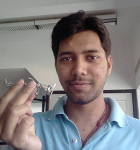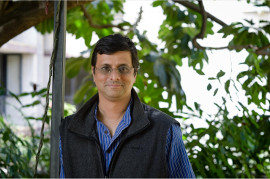BSc Biochemistry, Sri Venkateswara College, Delhi University
Odor tracking in flies

Nitesh Saxena
niteshs at ncbs dot res dot in
My bachelor's program in Biochemistry (SVC, Delhi University) was a mixed experience. I did not quite enjoy the dry wet lab work but, liked enzyme kinetics and molecular signaling at cellular level. These topics gave an impression that you can play around mixing different molecules and construct new systems which do something totally different than each of the constituent components. This gave a certain sense of creative power to make new kinds of micro-machines, or at least that’s what I felt at the time. Joining NCBS raised my hopes further because one could see very different kinds of researches in one place without any rigid divide between disciplines. This work environment also shows in the composition of the lab groups where engineers and physicists try to understand biological problems, while biologists struggle with intimidating equations and software codes. Such an environment is a very ripe place to widen your horizons simply because you get to understand their different interests and appreciate new things in life.
So...I give lot of attention to a fly. I mean who wouldn’t? Its like a toy robot which can move around at very fast speeds, flapping its tiny wings at ~250 Hz and tracking the faintest of smells to find food in the remotest of places, except that such toys are still far in the future and flies have been buzzing around for over 200 million years! To understand the high-tech fly you need to bring the best of your own technologies. One such tool is a high speed camera – which works like a normal camera except it can see even the fastest of animal movements without getting a blur in the image. Add a good quality zoom lens to this camera and you can see the fly in slow motion, it is like your world has synced in time with that of the fly. Now, the random buzzing of a fly starts appearing more controlled and well-guided. I study the food searching behavior in fruit flies, D. melanogaster, in the presence of various distracting visual objects surrounding the smelly food sources. My work tries to understand how the environment influences the search behavior of flies and conversely, how do flies use different sensory signals present in the environment to locate a very small point food source.



